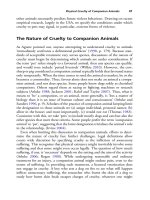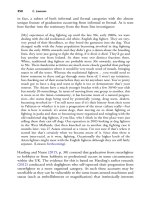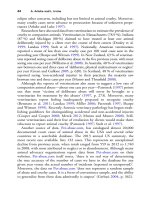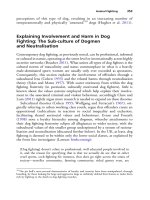The palgrave international handbook of a 198
Bạn đang xem bản rút gọn của tài liệu. Xem và tải ngay bản đầy đủ của tài liệu tại đây (46.38 KB, 1 trang )
Slaughterhouses
191
Pachirat: Working in the chutes took me out of the sterilized environment of
the cooler and forced a confrontation with the pain and fear of each individual
animal as they were driven up the serpentine line into the knocking box.
Working as a quality control worker forced me to master a set of technical
and bureaucratic requirements even as it made me complicit in surveillance and
disciplining my former coworkers on the line (Solomon 2012).
Such instrumental rationality and compliance to what become bureaucratic
processes distract and overwhelm any lingering moral questions. As Pachirat
notes, ‘at the rate of one cow, steer, or heifer slaughtered every twelve seconds
per nine-hour working day, the reality that the work of the slaughterhouse
centers around killing evaporates into a routinized, almost hallucinatory blur’
(2011, p. 138).
Hamilton and Taylor (2013, pp. 78–80), based on their ethnographic
work in UK slaughterhouses, demonstrate how violence to animals in the
slaughterhouse is normalised through a ‘reverence for the efficiency of the
machine and of the technology housed within it’. Considering how slaughterhouse workers refer to animals as ‘units’ and their deaths as ‘processing’,
they argue that language and pride in technology combine to contribute to
‘the ideological obfuscation of them [animals] as embodied subjects. . . .
Language is used here to sanitise and justify their deaths’ (p. 79). This
reverence for efficiency and technology, seen for example in the pride
taken to kill animals ‘every twelve seconds’ (Pachirat 2011), is part and
parcel of the ways in which animal deaths in the slaughterhouse are made
palatable.
Justifying Slaughterhouse Violence:
The Roles of Language and Technology
Technology can be used to perpetrate but also sanitise violence. It can be
used to extend the magnitude of violence, allowing humans to execute
violence much more efficiently than if perpetrated manually. Because
machines, devices and ‘innovative methodologies’ can all be used for violent
purposes and ends, documenting their use is a helpful step to recognising
slaughterhouse violence. For example, Roe (2010) provides an excellent and
detailed analysis of the treatment of pigs, sheep and other livestock from the
farm to the slaughterhouse.
As we have indicated above, knowledge from other hidden, state-sanctioned
and approved violent practices can be very instructive as they can help us to see









